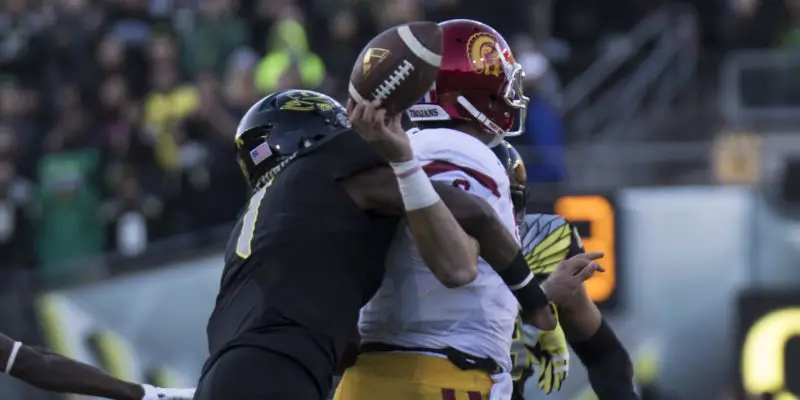Oregon’s spring game is just days away, and, in case you missed it, there were some major changes to the coaching staff.
The most anticipated change came at the defensive coordinator position with the hiring of Brady Hoke, who has never held the position before. In his early years, Hoke established himself as an excellent defensive line coach, spending six years at Oregon State and six years at Michigan. In 2003, Hoke became the head coach at Ball State where he spent six years before moving to San Diego State for two years.
In 2011, Hoke returned to Michigan as the head coach for the 2011-2014 seasons. Collectively, Hoke has been a collegiate head coach for 12 years. Mark Helfrich made clear that as a head coach Brady Hoke has been intimately involved with each and every defense. During his tenure at Michigan, Hoke made significant improvements to the defense in his first year.
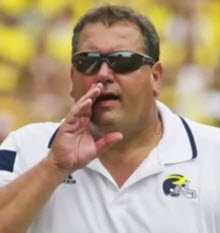
Brady Hoke
Before his arrival, the 2010 Big Blue defense ranked 110th in yards allowed and 108th in scoring defense. In 2011 and 2012, they improved to top 20 rankings in scoring and total defense for each year. In Hoke’s final season, the Wolverines were ranked 7th nationally in total defense, and he did it with a 4-3 scheme.
Oregon has been running a hybrid 3-4 defense since the 2010 season. Hybrid or not, the defense was a 3-4 at its base. And, although it was successful for a time, the 2015 season was a defensive disaster that ended with the worst bowl game loss in college football history.
Exactly two weeks later Oregon announced the hiring of Brady Hoke as the new defensive coordinator and would be installing his 4-3 defensive scheme. So what can we expect from the new 4-3 defense? Are there any reasonable expectations?
To answer these questions, I found every college football team in the Power Five conferences that run a 4-3 defense and compared them to every Power Five team that runs a 3-4 defense. Of the 64 teams in the Power Five, 16 teams run a 3-4 and 26 run a 4-3 base defense. The other 22 teams run multiple fronts or other schemes such as the 4-2-5 or 3-3-5.
When examining key indicators of defensive performance, there is a clear trend. On average, the teams in the Power Five that run a 4-3 defense, outperform 3-4 defenses.
For example, the median number of yards allowed per play for all the 4-3 defenses in the Power Five is 5.3 yards per play. In comparison, the 3-4 defenses in the power five allowed 5.65 yard per play. Now that doesn’t sound like much of a difference. But, by looking at a boxplot, the comparison becomes much clearer. Boxplots are great because we can clearly visualize the data.
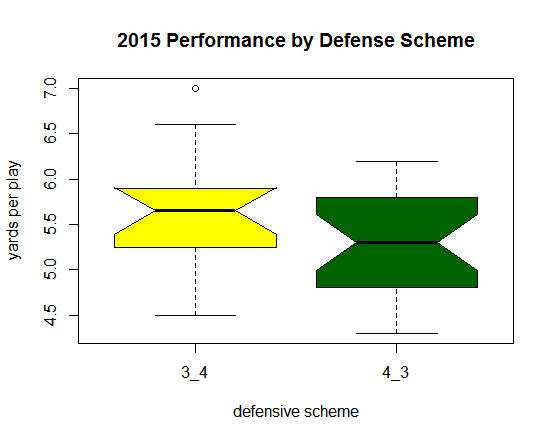
In the case of yards per play (above), it is clear that 4-3 defenses in the Power Five allow fewer yards per play across the upper and lower bounds and the median. Each box represents the data between the 75th percentile and the 25th percentile. A percentile is a form of rank ordering. For example, a defense that ranks in the 75th percentile is a defense that is ranked higher than 75% of the other defenses.
The notched horizontal black line represents the median (i.e. 50th percentile). And the “whiskers,” or the vertical lines, extend out to minimum and maximum values while excluding extreme outliers. Extreme outliers are represented by dots.
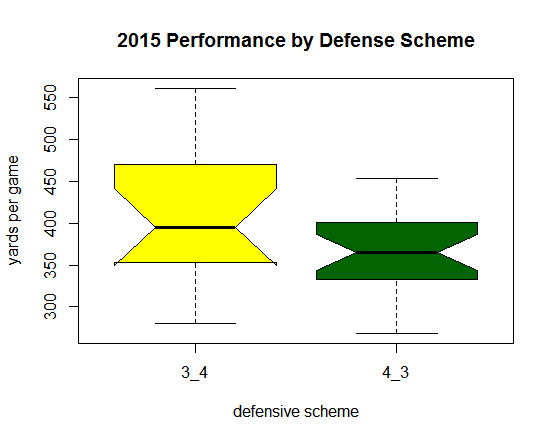
To further clarify the comparison, look at the total yards per game. Comparing the total yards per game, in the plot above, the 3-4 defense looks even more porous. Here we can see there is much more variation in 3-4 defensive schemes as evidenced by the much larger range of total yards per game.
By comparing the yards per game boxplot with the yards per play boxplot, you might correctly conclude that 3-4 defenses are on the field more often and longer.
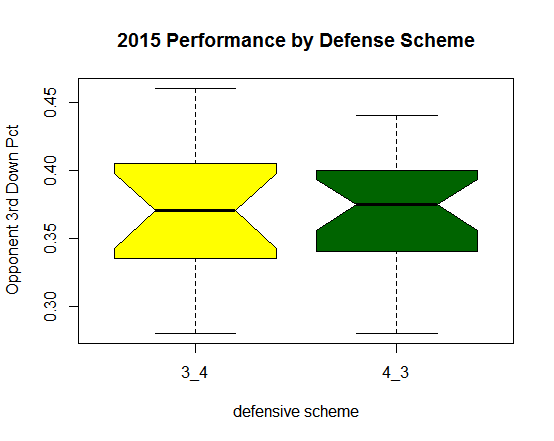
Although 3-4 defenses are subject to more plays per game, this trend is not explained by third-down conversion percentage. In fact, the two defensive schemes are nearly identical across the Power Five conferences in third-down conversions, as can be seen in the above plot.
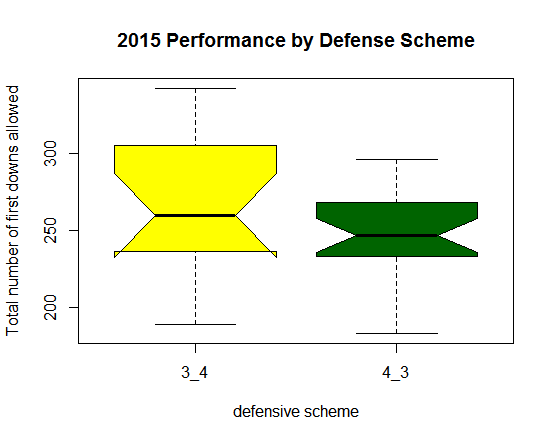
However, if we look at total first downs in the plot above, we can see that 3-4 defensive schemes allow significantly more first downs. This implies that opponents are moving the chains more often on first and second downs. This is perhaps a result of 2-gap techniques vs an attacking 1-gap technique, but I’ll leave that conclusion to be made by tactical experts.
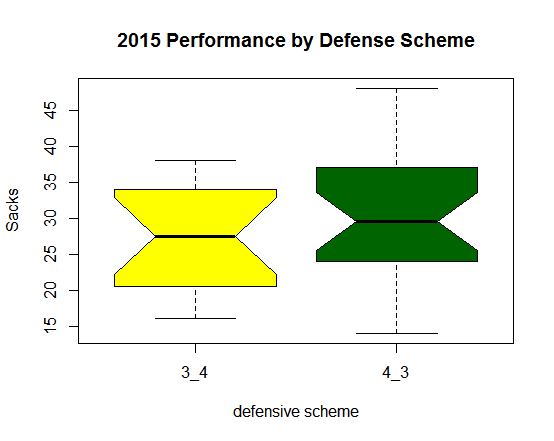 Total team sacks is another area where 4-3 defenses seem to outperform the 3-4 defenses in the Power Five conference. In the boxplot of total team sacks (above), you can see that across the Power Five conferences, 4-3 defensive schemes have more total sacks at the 25th and 75th percentiles.
Total team sacks is another area where 4-3 defenses seem to outperform the 3-4 defenses in the Power Five conference. In the boxplot of total team sacks (above), you can see that across the Power Five conferences, 4-3 defensive schemes have more total sacks at the 25th and 75th percentiles.
 However, one area where 3-4 defenses significantly outperformed 4-3 defenses was in the Red Zone. The percentage of touchdowns (above) allowed in the Red Zone is higher among the 4-3 defenses at the median. This is possibly the result of having more linebackers in the Red Zone. We all remember when Tyson Coleman blitzed Kevin Hogan, forcing a quick throw that was batted down by Joe Walker, right?
However, one area where 3-4 defenses significantly outperformed 4-3 defenses was in the Red Zone. The percentage of touchdowns (above) allowed in the Red Zone is higher among the 4-3 defenses at the median. This is possibly the result of having more linebackers in the Red Zone. We all remember when Tyson Coleman blitzed Kevin Hogan, forcing a quick throw that was batted down by Joe Walker, right?
Admittedly, Oregon was no daisy in the Red Zone last year. In fact, only Maryland was worse among this group. But this is a good example of where 3-4 defenses appear to have an advantage, and that is certainly not the only advantage.
I’m not here to make sweeping conclusions about the merits of one defensive scheme or the other, as I’ve only discussed a handful of defensive statistics, and the story certainly goes much deeper. But as we anxiously await Oregon’s new defense, one can only imagine and hope. My intention has been to excite, encourage and give a glimpse of what we can hope to expect.
And that would be a vastly improved defense under a fresh, attacking 1-gap scheme!
Evan Markel
Statistical Analyst for FishDuck.com/DayliO Inc.
Knoxville, Tennessee
Top Photo by Gary Breedlove
Evan is a native Oregonian who grew up in the historic town of Oakland, once known as the Turkey capital of America. Evan attended the University of Oregon and is a Lundquist College of Business alumnus, and he has a Masters in Statistics and a PhD in Natural Resource Economics from University of Tennessee
While at Oregon he attended nearly every home football game and fostered his love for all things Oregon Duck. He now works for Ernst & Young amid the Huskies in downtown Seattle, and loves using his skills to study his beloved Ducks.

